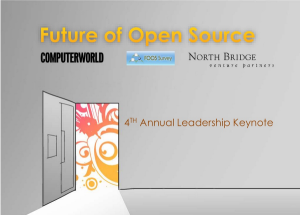This was originally published on March 20, 2010 on novell.com :
With another chapter of the Open Source Business Conference concluded, I want to reflect on what the industry is buzzing about and where open source is headed. There’s no doubt that to find the buzz this year, you simply had to look up. The cloud was the hot topic at OSBC.
The most compelling talk of the week was Tim O’Reilly’s keynote. (Don’t ever miss a chance to hear him speak!) Tim’s initial message was that the cloud isn’t (just) what you think it is. It’s not just a scalable, remote data center. It’s a vast multitude of business and consumer services delivered to a plethora of devices – computers, phones, UI-less sensors, and many others. He offered the example of a scale that connects wirelessly to a service that tracks and reports on your weight via the Web. Not that it’s groundbreaking, but that it’s representative of where the cloud is headed. Tim further predicted that innovation will focus as much on hardware devices as on cloud services.

His most significant observation was that the whole basis of customer lock-in is changing due to the adoption of cloud computing. Lock-in will no longer be achieved through proprietary software, but through proprietary data. He quoted Google’s Director of Research, Peter Norvig, as saying, “We don’t have better algorithms than anyone else. We just have more data.” While some might doubt the first statement, there’s no question the magnitude of Google’s data gives it a tremendous lead in search and many related markets. Tim urged the audience to develop networks of loosely coupled cloud services, based on open APIs and open data, to prevent a single, dominant player from gaining control of the whole cloud ecosystem.
Curiously, there wasn’t as much discussion of security and compliance in the cloud as I had expected. Maybe people aren’t thinking of moving critical services and data to the cloud yet. But I would argue this is a circular issue: as people learn about enterprise-grade solutions for security and compliance in the cloud, they’ll begin expanding their view of which applications they can entrust to the cloud. Enabling true portability of workloads across physical, virtual and cloud environments – with all the attendant enterprise requirements – is in fact what we endeavor to provide at Novell with Intelligent Workload Management.
So where does open source software (OSS) fit in? For one thing, it’s ideally positioned to provide the infrastructure for public and private cloud environments. This is a widely accepted view today, and we see it taking shape with (for example) our announcement that SUSE Linux Enterprise Server is powering IBM’s new development and test cloud.

The results from North Bridge Venture Partners’ “Future of Open Source Software Survey,” revealed at OSBC, also give us some clues about where open source is going. OSS users and vendors reported that OSS is so attractive for three main reasons: lower costs, rapid pace of innovation and freedom from vendor lock-in. OSS’s rapid innovation was an advantage cited frequently throughout the conference, no more so than by SugarCRM’s CEO, Larry Augustin, who argued passionately that customers don’t just care about saving a few dollars; they care about doing more with the limited budget they have. The pace of OSS innovation eclipses that of proprietary software and positions it to keep growing rapidly, no matter what the economic climate. In other words, OSS is here to stay and will only become more essential – due to its cost, quality and innovation advantages.
Lastly, I had the pleasure of organizing a panel of executives from IBM, SAP, Ingres and GroundWork Open Source, who discussed the key role of OSS in driving the nascent software appliance market. They described how software appliances help them get to market faster, reach new customers, and reduce their support requirements. They pointed to the flexibility and reliability of SUSE Linux Enterprise Server and Novell’s appliance program as key enablers. All four companies are working with Novell to build and sell appliances, with impressive results to date. Peter Jackson, CEO of GroundWork Open Source, boasted of acquiring 100 new customers in the first 100 days and predicts he’ll acquire 1,000 new customers in the first year with appliances. Ingres and Novell also announced a pre-configured appliance template with Ingres Database, making it even easier for software vendors to quickly build complete appliance solutions. Deb Woods of Ingres also noted that appliances are helping them prepare their customers to ultimately deploy on the cloud.
That’s all from a dynamic week in San Francisco. Time to grab some quick R&R before getting ready for Novell BrainShare. Hope to see you in Salt Lake City!

